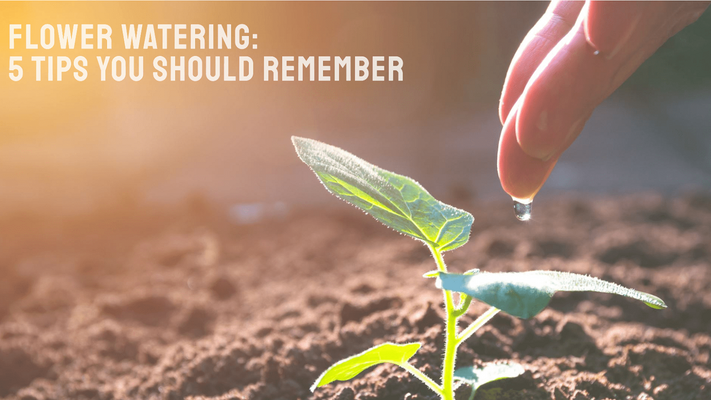Mastering Flower Watering: 5 Tips for Keeping Flowers Fresh

So, you’ve decided to grow a flower? Gain confidence in the garden by equipping yourself with some watering knowledge. Incorrect watering is one of the most common reasons for failing to grow a flowering plant or a plant in general. But that’s easy to remedy. We’ve listed five essential things to remember when watering your flower plants. Keep these in mind, follow the tips and soon you’ll be seeing those blossoming beauties growing healthy.

1. The soil tells it all
Your flowering plant’s soil will tell you know when it is ready for drinking. There are many ways to check the soil and one of the easiest and low-cost ones is the Finger Test. All you need to do is stick your index finger down into the soil. If the first 1-1.5 inch of the soil feels dry and your finger comes out clean, it’s time to water. There’s no need to water if the soil feels moist. Flowers in medium-sized pots will benefit most from the Finger Test.

Another way to test the soil is the Wooden Skewer Test that’s perfect for those who don’t want to get their hands dirty. Stick a skewer into the soil – almost all the way in for large pots and 1-2 inches for mid-size pots. Then slowly remove the skewer and check the dampness. If soil sticks to the skewer, don’t water yet. If soil didn’t stick or if it falls off easily, water.
You can also get a moisture meter which is an instrument that measures the amount of moisture in the soil.
2. The Watering Tools Matter
The watering method and tool you’ll use will depend on what you will water and where it is planted. A soaker hose is the efficient choice when watering flower beds or flowers on the ground.

A spray nozzle will be helpful in directing water to the base of individual flowering plants. There are different spray nozzles that allow you to get the watering control your plant needs. For a gentle spray of water in between lush foliage, a watering wand would be useful. For new flower beds, sprinklers that deliver gentle moisture would be perfect.
3. Early morning's the perfect time
The best time will be between 5:00 and 10:00 in the morning. The temperature is cooler in the early morning so there will be less evaporation and water can stay where it needs to. Then again, just in case you get water on the leaves, the water will have time to evaporate so the leaves will stay dry. Watering in the morning also ensures the plant is hydrated and capable of withstanding warm afternoon temperatures.
Watering at night isn’t really a good idea because the leaf surface will remain wet overnight thereby inviting fungi.
4. Thorough is better than often
Resist the temptation to water your flower garden whenever you look at them. In general, flower gardens only require a few mills of water every week. Usually, once or twice deep watering per week will be sufficient for most flowering plants. It is highly advisable to water less often but with lots of water than to water little by little every so often. Make sure you give water in parts to allow it to seep into the soil. Water around the flowering plant and not just on one side or spot.

Shallow watering also discourages deep root development so remember to water deeply so that you reach roots.
5. Keep flowers and leaves dry
Wet leaves are more likely to become diseased leaves. Water left on the foliage overnight will cause moulds to grow on the leaves. Water on the foliage under the scorching heat of the sun would cause burn marks. Top watering can break the flowers, too.

Note, however, that certain flower varieties prefer wetter or drier soil so this must be taken into consideration. Weather will also affect the moisture your soil needs. So, during hot dry spells, frequent deep watering may be necessary.
Mastering the art of watering your flower plants can greatly increase their health and longevity. It's crucial to understand that the soil conditions, watering tools, timing, watering quantity and method can all significantly impact your plants' wellbeing. Utilise the finger test or a wooden skewer to ascertain soil dampness, and consider using tools like a soaker hose or a spray nozzle for effective watering. Aim to water early in the morning to reduce evaporation and fungal growth, and opt for deep watering, rather than frequent shallow watering. Lastly, avoid wetting leaves and flowers to prevent disease. Remember, each plant variety may have unique watering needs, and weather conditions can affect soil moisture necessities.
